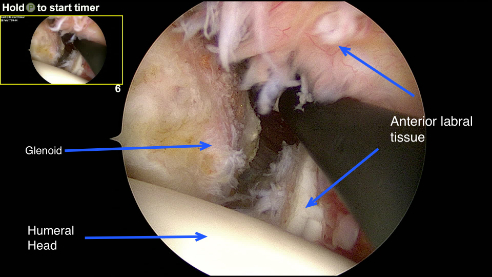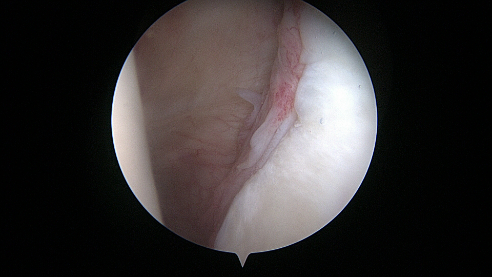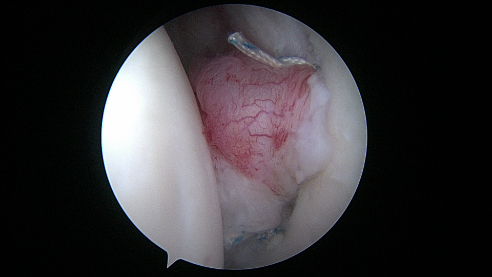Shoulder Dislocations
The shoulder is a very mobile ball and socket joint. This gives it the great advantage of being able to move our hand and arm in many directions. To permit this great mobility, the socket must be very shallow and, as such, the stability of the shoulder is very dependent on the surrounding muscles, tendons and ligaments to keep it in joint. Any condition or injury that disrupts these structures can lead to the shoulder slipping slightly out of joint and back in again (subluxation or partial dislocation) or coming out completely (dislocation).
Why does it happen?
There are three main reasons for the shoulder to feel unstable or dislocate.- Trauma
This usually results from a fall or an accident. In sportsmen this is most frequently due to a tackle or collision event. In these traumatic cases, the shoulder often stays out of joint (dislocates) and requires someone to put it back in joint. In over 90% of cases, the shoulder dislocates forwards and downwards (anterior). Traumatic dislocations are almost always associated with damage to the structures that stabilise the shoulder. This makes the shoulder more prone to dislocations in future.
- Atruamatic
In this group of patients, there is often no specific traumatic event or the trauma has been relatively minor. Despite this, patients can experience the sensation of their joint slipping or it even coming out of joint completely. This tends to occur with the arm in certain positions or even during their sleep. The shoulder almost always relocates itself rather than needing to go to hospital to have it put back. These patients have a greater degree of laxity of the ligaments that hold the shoulder in joint and a similar degree laxity can usually be seen in other joints. It is less frequent to have any underlying joint damage in these cases. - Non-structural atraumatic
These patients can dislocate their joints at will and may demonstrate a dislocation as a party trick. This is usually painless and there is no previous history of accidents or trauma. This form of instability is due to muscle imbalances and a change in the coordination of the muscles that control the stability and movement of the shoulder.
How is it treated?
The treatment is very much based on the cause of the dislocation. For all causes, however, physiotherapy is a fundamental part of successful treatment.Physiotherapy
This is essential to regain safe controlled and balanced movement in the shoulder. In many cases, this is all that is needed.
Surgery
There are several operations that are used in treating unstable and dislocating shoulders and these are based on the repairing or addressing the underlying damage. In young individuals who sustain traumatic dislocations, there is a high chance of the shoulder re-dislocating in the future if left alone. This is particularly true in those who take part in collision sports, overhead sports and manual jobs. In these cases, a good success rate can be achieved by surgically stabilising the shoulder. Surgery available for shoulder dislocations includes:

Arthroscopic view of anterior labral tissue during repair

Arthroscopic view of dificient anterior labrum

Arthroscopic view following anterior labral repair
- Arthroscopic labral repair – in the majority of traumatic shoulder dislocations, the labrum is damaged or torn. This tear is also known as a Bankart lesion and can even extend to involve the bone of the socket (Bony Bankart lesion). To restore shoulder stability and reduce the chances of redislocating, the labrum can be repaired back to the edge of the socket using keyhole surgery. This requires two to three small incisions through which the labrum can be restored back to its original position on the edge of the socket.
- Latarjet procedure – the Latarjet procedure was described by the French Surgeon Dr Michel Latarjet in 1954. It is used in cases of recurrent shoulder instability where surgery has been performed before and the shoulder continues to dislocate. It also has a special role in managing shoulder dislocations where there has been damage to the bone of the humeral head or the socket or both. This procedure can be performed using keyhole surgery (Arthroscopic Latarjet), open surgery or a combination of the two.
What are the potential complications?
Complications are uncommon, but include getting a stiff shoulder or recurrence of dislocations. Further possible, but rare, complications include infection, nerve damage, pain, and wound-healing problems. Finally, specific to the Latarjet procedure, non-union (non healing) and malunion of the bone transfer.What rehabilitation is necessary after surgery?
The surgery can be performed as a day case procedure meaning you can leave hospital the same day as your operation. A period of immobilisation in a sling is then needed for four to six weeks and your stitches can be removed after 10 days. A structured course of physiotherapy is started immediately. Driving can be commenced after six to eight weeks subject to review by your surgeon and physiotherapist. Return to contact sports is considered from three months post surgery.Testimonials
A big thank you to Simon and his team for their care, patience and perseverence looking after me through all stages of both shoulder and elbow surgery.
Since the shoulder stabilisation I have continued my sailing and fitness training without the worry that my shoulder might dislocate; and I don’t have to think twice whether my ulnar nerve will hinder any progression in my sports.
With their amazing help, I’ve been able to get back to sailing competatively and am now a double National champion.
After multiple shoulder dislocations Charlie helped me set a route for recovery, which has been nothing but smooth sailing. Surgery went successfully and I am well on my way to playing the sports I was previously. Would highly recommend.
Simon successfully operated on my frozen left shoulder in 2012 with fantastic results. This year he has overseen and advised treatment for my frozen right shoulder (via hydrodilation injection). His unrivalled experience in orthopaedic shoulder treatments, coupled with his reassuring bedside manner and excellent results, gave me huge confidence throughout. I’m hugely grateful to have my quality of life back and wouldn’t hesitate to recommend his services. Thank you Simon.
I had suffered with a painful shoulder and pins and needles for three years following a right shoulder fracture and failed half joint replacement prior to meeting Mr Pennington. He explained the situation in a way I could relate to and I’m delighted to say my revision shoulder replacement has gone well and for the first time in years I can use my arm and am pain free. I was even able to walk my daughter down the aisle 3 months after surgery! Many thanks.
I would like to thank Charlie Talbot and his team for the operations performed on both my shoulders and also the aftercare put in place after my operations. I have played golf since I was 12 years of age and thought at one point that I would never get back to playing again. Charlie was always very positive and told me that he would get me playing golf again. Well, I have now been playing golf for nearly 2 years. Before surgery I had a handicap of 12 and I am now down to 9, not bad at the age of 68. So many many thanks.
I had PRP injections into my right elbow last year and within 3 months I was pain free, a year on it is more or less 100% better. Fabulous I would recommend it to anyone with Tennis Elbow, in fact I have gone back again this year to get my left elbow done. Thanks Simon.
Mr Pennington I really wanted you to know how very thankful I am for the excellent care & treatment you and your staff gave me. It really meant a lot that you were so clear, friendly & professional and listened to me – so thank you again.
After more than four decades of shoulder problems with a total of three surgeries the full shoulder replacement surgery by Mr. Talbot has changed my life beyond expectations. I am now able bodied for the first time in years and pain free.
Thank you to Mr Boyle and team for the excellent care and attention both before and after Replacement Shoulder surgery, using the Tornier Simpliciti procedure. After very many months of severe pain and lack of movement I was pain free from day one. Now, after nine weeks, the shoulder and arm movement continues to improve, beyond expectation, with physiotherapy and exercise. I am extremely grateful for all the continuing care.
Following two years of recurrent problems with my left shoulder I was recommendedto Consult Mr Neil Pennington. I had the opportunity to have my surgery quickly and at my convenience, this fitted well around my professional and home commitments. The surgery was carried out as a day case procedure and Mr Pennington visited me following the surgery to explain everything. My operation was a minimally invasive procedure so my recovery was straightforward with only a few restrictions; in fact I was encouraged to keep my shoulder moving. I was driving and back to work after 2 weeks – after 2 years of pain and sleep disturbance I found this operation to be life changing! I found Mr Pennington to be a very professional and compassionate surgeon and he is surrounded by a whole team of professionals that gave me the utmost confidence in the care and treatment I received.
I would like to thank Mr. Talbot and the amazing team of nurses, physiotherapists and support staff for their care and support during my recent visit to the Duchy Hospital, Harrogate, for a replacement shoulder. The care and attention I received was unparalleled. The pain free movement I now have has changed my life.


